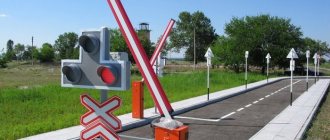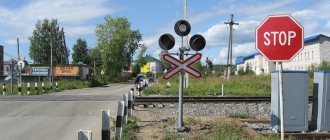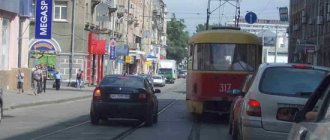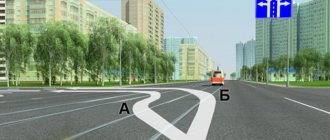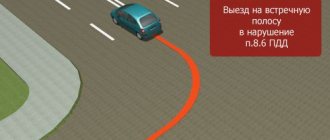General rules of conduct on the railway
These rules include:
- You cannot travel on railway tracks.
- It is necessary to cross railway tracks only in those places that are equipped with pedestrian platforms.
- If the barrier at a railway crossing is closed or the traffic light is red, it is prohibited to cross the crossing.
- You cannot crawl under carriages or climb over trailer chains.
- Along the tracks you must walk at a distance of more than 5 m from the outermost rail.
- If railway bridges or tunnels are not equipped with walkways, you cannot pass through them.
- When a train in one direction passes, you need to make sure that there is no route in the opposite direction and only then cross the tracks.
- While crossing the tracks, you cannot talk on the phone or use headphones.
- Climbing onto electrical poles is prohibited.
- Do not touch electrical wires that lie on the ground.
- It is prohibited to climb into tanks and other railway objects.
- It is forbidden to get caught on a moving train.
In Russia, 6-8 railway accidents occur every day.
Responsibility of parents for the actions of children on railway transport
Parents bear full responsibility for the actions of children on railway transport. It is the responsibility of each parent to explain railway safety rules to children.
Important! Children should not be left alone near railway tracks. This is dangerous for their lives.
Those children who play near railway tracks endanger their lives. It also puts the health and lives of other people at risk.
Rules of conduct when on railway transport
Crossing or passing Russian Railways tracks must be carried out subject to the following rules:
- Crossing paths is permitted only in those places designated for this purpose.
- It is allowed to cross paths on foot or by vehicle only at specially equipped pedestrian crossings, bridges, tunnels, crossings and other places that have special road signs. We should not forget about the need to focus on signals coming from railway workers and special technical means.
- Persons with limited mobility who use a wheelchair are allowed to cross railway tracks only at pedestrian crossings and accompanied by an assistant.
- Motorists, motorcyclists and other road users when crossing railway tracks must be guided by the current Rules of the Road.
The railway has always been a place of increased danger for people, so today there are many serious prohibitions regarding behavior on the tracks and landing platforms. Strictly prohibited:
- crawl under the carriages of any railway transport;
- crawl under platforms;
- be in the wagon coupling area;
- cross the boundary line on the platform and approach its edge;
- run along the platform when railway transport is departing or approaching it;
- play outdoor games (this rule especially applies to children and adolescents);
- allow children of any age to be left unattended;
- jump off the platform on the way;
- Regardless of the presence or absence of a train in the visibility zone, it is prohibited to approach the tracks if the prohibitory traffic light is on and the barrier is lowered;
- try to climb supports and various structures of overhead contact networks, fences, power lines;
- approach power lines, including damaged ones;
- appear in the railway area to persons in an inadequate state, as well as in any form of intoxication;
- engage in any activity that may lead to damage or loss of main or auxiliary railway facilities and public places;
- install your own or damage already installed information signs; it is prohibited to break them, dirty them, or cover them, preventing the information from being read;
- forget or deliberately place your belongings of any size on the railway tracks;
- carry things that could cause injury, cuts or wounds to other citizens;
- carry or transport on trains any substances dangerous to humans that can lead to poisoning, fires, explosions or intoxication;
- do not create obstructions on tracks or platforms that impede the passage of trains.
Along with the prohibitions, there is a list of what passengers must do on the tracks or platforms:
- prevent in every possible way the creation of obstacles to the passage of railway trains;
- inform railway workers by any available means about any obstacles to traffic along transport routes;
- when approaching any train, move away from the edge of the platform or embankment to a safe distance;
- give any visual signal to the train driver if a situation arises in which it is necessary to urgently stop the train;
- Be sure to hold children of any age by the hand, small ones - in your arms;
- notify railway employees about discovered ownerless items located at stations, platforms, near the tracks and in other places.
When traveling on trains with a train ticket in hand, it is prohibited to perform a number of actions that could lead to adverse consequences not only for yourself, but also for the people around you:
- approach the train until its final stop;
- touch or lean against the cars, even if it seems that the train will not leave in the near future;
- overlook children and teenagers when entering and exiting the carriage;
- run into or jump out of the train as it moves;
- be on the steps, transition platforms, roofs of cars;
- prevent automatic doors from opening or closing;
- stick your head, arms and other parts of your body out of window openings;
- while the train is moving, be in places not intended for the carriage of passengers;
- attempt to damage parts of any train;
- smoking in carriages while on commuter trains;
- smoking on long-distance trains in places unsuitable for this.
Boarding and disembarking the carriage requires extreme caution, because at these moments there is a high risk of serious injury, therefore:
- It is prohibited to create obstacles for the passage of other citizens;
- boarding and disembarking are carried out only while the train is parked;
- if there is a platform at the station, boarding and disembarking are carried out through it; if it is absent, then through specially designated and adapted places;
- Children should be held by the hand or in your arms.
Violation of any of the above Rules leads not only to administrative liability, but also to a threat to the life and health of passengers, including the violator himself.
What preschoolers should know about railroad safety
There are rules of conduct on the railway that parents should explain to their children. Compliance with them will help avoid tragic events.
Important! You cannot force a child to follow the rules by order. Otherwise, he can do everything for evil. It's better to explain everything in the form of a game.
Rules for crossing unregulated railway crossings
These rules include:
- Before the flooring you need to stop.
- Look in both directions and listen to see if you can hear the train moving.
- Make sure that there is no car coming from behind, look in both directions again and only then cross the path.
Crossing the path is prohibited. Movement can only begin when the barrier is in a vertical position, even if the green light is on.
Important! It is necessary to understand that the train cannot stop immediately. To stop a train moving at a speed of 60 km per hour, it must travel at least another 600 m.
Safety rules when crossing railway tracks by car
To safely cross railway tracks by car, you must follow the following rules:
- You can cross the tracks only at special railway crossings.
- When the barrier begins to close, crossing the tracks is prohibited.
- You cannot try to open the barrier yourself.
- Regardless of the position of the barrier, you cannot drive when the traffic light is red.
- At night you need to be extremely careful. It is necessary to listen to all noises. Before moving, you should turn off the music and avoid talking on the phone.
- You must stop at a distance of 5 meters from the barrier. If there is a stop line or a special sign, then you should stop in front of them.
Rules of conduct for children during the holidays
Important! Any difficult situation that arises at a crossing is prohibitive: traffic jam, red light when the barrier is raised, etc.
How to behave on the platform
The place from which passengers board and disembark the train is called the platform. There are also certain rules here. There are white and yellow lines on the road surface at the landing platforms. You cannot place things behind them or cross them when a train is on the rails or moving along them. Also, do not cross them when it is announced that a train is arriving.
Important! While on the platform, you must not lean against the carriages. You cannot jump from the platform onto the rails. You cannot run along the rails after a departing train.
A reminder for children and their parents about safety at the railway station
Children must firmly understand that the train station and tracks are not a place to play. You are not allowed to ride a bicycle, rollerblades or skateboard on the platform. Adults should hold a small child's hand.
Behavior at the station:
- You cannot arrange games or other entertainment (taking photographs or filming).
- You cannot get on or off until the train has completely stopped.
- You should only go out on the side that has the landing platform.
- It is life-threatening to be on the railway tracks while intoxicated.
- Children should not be left unattended on platforms or in carriages.
- It is prohibited to jump from the platform onto the railway tracks.
- It is prohibited to organize active games on the platform.
Important! Adults must understand that following the rules is not only a legal requirement, it is the norms of etiquette in society. Until parents begin to show correct behavior by their own example, the situation will not change.
Rules for crossing railway tracks and passages along tracks
When on the railway tracks, the conductor must comply with the following requirements:
- go to and from the place of work only along specially established routes, marked with “Service Passage” signs, pedestrian paths, tunnels, passages and passages;
- walk along the tracks only on the side of the track or in the middle of the track, paying attention to the rolling stock moving along adjacent tracks;
- cross railway tracks not occupied by rolling stock only at right angles, after making sure that there is no rolling stock moving at a dangerous distance in this place;
- cross the track occupied by rolling stock, using only carriage vestibules or carriage transition areas;
- when getting off the car, hold on to the handrails and position yourself facing the car, having previously inspected the place where you got off and made sure that the handrails, steps, steps are in good condition, as well as that there is no rolling stock moving along the adjacent track;
— bypass groups of cars or locomotives standing on the track at a distance of at least 5 meters from the automatic coupler;
— pass between uncoupled cars, if the distance between the automatic couplers of these cars is at least 10 meters;
— pay attention to traffic lights, sound signals and warning signs;
— special caution must be observed in the dark, when visibility and audibility of signals are poor, as well as in ice and snowfall.
The conductor is prohibited from:
- cross or run across the tracks in front of a moving train;
— cross the vestibule of an electric train;
— crawl under the carriages;
- stand or sit on the rail;
- walk inside the track and at the ends of the sleepers;
- to be on the intertrack between trains when they are moving non-stop along adjacent tracks;
— cross the switches equipped with electrical centralization at the points where the points are located;
- stand between the point and the frame rail, the movable core and the guardrail, in the gutters on the switch and on the ends of the reinforced concrete sleepers;
- to be in places, about, and also near these places when passing rolling stock.
When going out onto the railway track from premises, from a carriage, because of buildings that impair the visibility of the track, as well as in bad weather conditions (fog, ice, etc.), you must first make sure that there is no rolling stock moving along it.
When leaving a dark room into a brightly lit one (or vice versa), you need to wait until your eyes get used to it, after which you can continue moving.
